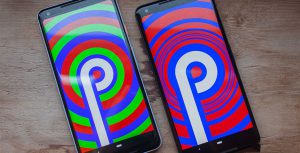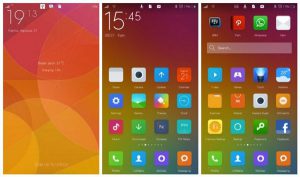 It's hard to imagine a world without Android. It has been nearly ten years since the first version of the operating system was released. Android OS immediately occupied its niche in the mobile operating system market and managed to become the most popular mobile system in the world, with a total number of users of over 2 billion people.
It's hard to imagine a world without Android. It has been nearly ten years since the first version of the operating system was released. Android OS immediately occupied its niche in the mobile operating system market and managed to become the most popular mobile system in the world, with a total number of users of over 2 billion people.
But what exactly is Android? The question is rather complicated. There are a large number of versions Android with different functionality, where each manufacturer tries to add something from himself to the operating system, unlike the same iPhone, where iOS – it's simple iOS, regardless of the generation of the “apple” smartphone. Therefore, all Android – smartphones look completely different. How does this happen?
Android is open source, which gives a lot of opportunities for system upgrades. However, it can be difficult for users to understand how it works. We will try to answer the most frequently asked questions about Android. If you don't understand how Android Nougat works or what Android Go is, be sure to read our article.
What is Android?
Android is an open source operating system (OS). “Open source” means that the system is completely open to third-party intervention and can be used by any user to customize it. Due to its “openness”, Android is used not only in smartphones, but also in many other electronic devices: set-top boxes, game consoles, cars, etc.
What is the difference between Android – a smartphone from iPhone? Excluding your personal preferences, you are unlikely to find much difference if you only use your smartphone for everyday tasks (calls, messages, surfing the Internet), since both systems handle these tasks equally well. If you want to play around with the settings within the system, then here you will find significant differences, since Android does not limit users at all, unlike iOS.
It is noteworthy that not only manufacturers Android – devices, but also ordinary users have access to advanced customization settings. On most modern Android devices, you can install custom firmware or a launcher if you are not satisfied with the factory version.
to the content
What is “naked” or clean Android?
You've probably heard of the “bare” or stock Android. But what is he like? This is by no means a cropped version. A “bare” Android is understood as a basic, or “clean” version of the operating system. It is also considered the most stable version, with which the development of various firmware and applications begins. This version can be found on Google Pixel smartphones of all three generations (in which additional chips have been added specifically for Google smartphones) and in some other phones from different manufacturers.

Of course, each user decides which version he will use based on his personal preferences, but the stock Android has one serious advantage – it is the fastest, most stable and least demanding version Android. This is because the basic version is made in a very minimalistic design, which is why it uses less smartphone resources. For example, the Google Pixel 3 runs smoothly not only thanks to the stock version of Android, but also due to the correct setup, which significantly reduced the barrier to entry for new users. The “naked” Android is exactly the one Android that Google intended it to be.
to the content
What is Android Pie (Android Pie)?
Have you ever wondered, “What is the difference between Oreo and Pie”? Each new version Android is accompanied by its own serial number and the name of some sweets. Each new version brings a large number of small changes, improvements to old features and the addition of new features. Therefore, there are so many different versions of the operating system, since each manufacturer represents one or another feature of the system in its own way, which is why such a phenomenon as fragmentation Android arose, which is both a plus and a minus platforms.

Android 9.0 Pie is the latest global Android update. The next Android 10.0 is to be announced at the Google I / O conference in May 2019. Since all names are in alphabetical order (the last was Pie), you should expect something with the letter “Q”.
to the content
What is Android Go and Android One?
If you follow the market of budget devices, then you have probably heard about the program Android Go or its predecessor Android One. Android Go is a light version of the “bare” Android for budget devices that can't handle the latest versions Android. Android Go was announced in 2017. This program is aimed at people with budget smartphones, mainly from India, Africa and Brazil.
Android One was the predecessor of Android Go. It can be considered the most resource-intensive version of Android. You may have already met one of them on smartphones like HTC U11 Life and Moto X4.
to the content
Multi-vendor skins and user interface
Google is not alone in constantly updating the look Android. Each manufacturer can create a proprietary shell for their devices, which is what most companies use. By the way, it is extremely difficult to find similar shells on the market: each has something different. The only thing that unites them is a significant difference from the basic version Android. These skins, or UI (user interface), can be very similar to the “clean” Android, for example, HTC Sense UI, which adds only a few minor features, or completely different from it: Huawei Emotion UI (EMUI), which differs both in appearance and functionality.

But do not worry about such an abundance of versions, since they all work plus or minus the same, so it will not be difficult for you to get used to the new shell. The main thing is that all applications work exactly the same on any UI. If the availability of the latest version Android is important to you, then you should pay attention to devices with basic Android, especially Google Pixel devices, or phones running Android One / Go, since such devices receive new updates directly from Google, so you will always be the first to try out a new update. Smartphones with other skins usually receive updates a little later, as their manufacturers have to update their UI for the new version. For this reason, the Samsung Galaxy S8 only updated to Android 8.0 Oreo in February 2018, while the eighth Android was released back in August 2017.
This is bad news from a smartphone security standpoint, as anti-malware systems improve with every new update. But branded skins are not as bad as they might seem at first glance. Each UI has its own advantages and features that you won't find on stock Android. For example, Huawei for their shell (EMUI) they have developed specially software for power management, which significantly outperforms their competitors; Samsung is adapting some apps specifically for its shell, and Motorola has added some very fun things to its budget line of smartphones. Nevertheless, all this is “taste”, so carefully study the shell of the smartphone before buying the device itself.
to the content
What is an Android “fork”?
This is not as important a point as all the previous ones, but if you liked reading about “naked” Android and its shells from different manufacturers, then you should definitely read about the division of Android smartphones.
As we wrote earlier, Android is an open source operating system, the vast majority of whose functions can be changed by anyone. This explains the huge number of different versions from different manufacturers Android – smartphones. Although Android is a free and open system for developers, you have to pay for using Google services, and if you, being a manufacturer of Android – smartphones, want to install Play Market on all your devices, – you have to pay.
However, not all manufacturers agree to pay money for using Google services. This is where the concept of “splitting” or “forking” Android smartphones comes in. This definition came from the development of alternative operating systems that were based on Android. Such operating systems are created because some manufacturers do not want to pay for using Google services. Perhaps you even used a smartphone on one of these OS, for example, Fire tablet OS from Amazon, running on Android, but without all the main Google services. You can find similar operating systems on various Chinese devices, which will be very similar to Android itself, but without the pre-installed Google services.
Fork Android may seem like a negative phenomenon, but not everything is so simple. Forks are just another kind of Android OS, and as long as Google maintains its operating system, you don't have to worry about its security.
